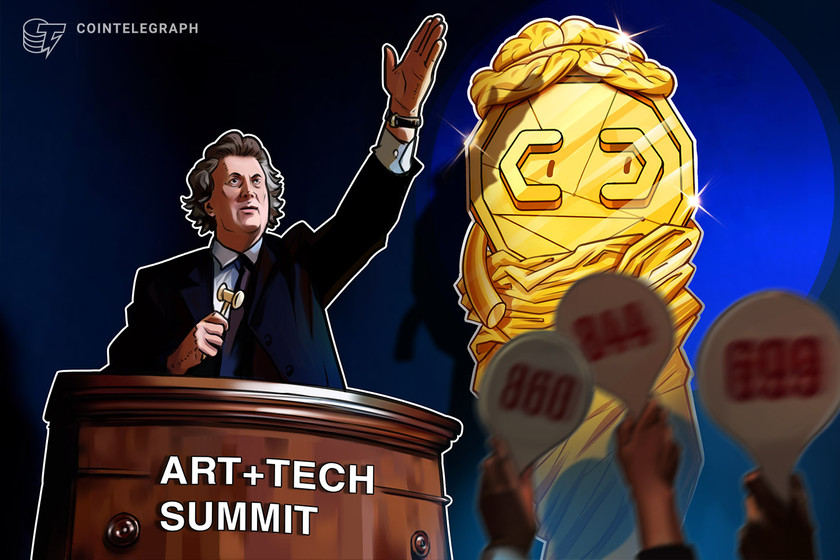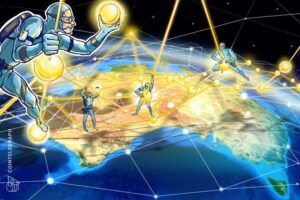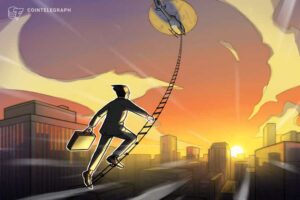Christie’s fourth annual Art+Tech Summit was dedicated to discussions of the future of art, collectibles and the world of nonfungible tokens.
Christie’s upscale building located in New York City’s Rockefeller Center, Midtown Manhattan. The organizers were exhibiting a 3D frame, which allows a hologram of oneself to be remotely projected elsewhere, and discussing how animated interactive collectible cards will change over time based on the real-life performance of the displayed athletes. Galaxy Digital CEO Mike Novogratz, Canadian artist Mad Dog Jones, head of global marketing at TikTok Nick Tran, co-creator of CryptoPunks Matt Hall, co-founder of Tezos Kathleen Breitman and president of TIME Keith Grossman — all movers and shakers in the art and tech space gathered (some of them virtually) at Christie’s fourth annual Art+Tech Summit to discuss the future of nonfungible tokens (NFTs).
The interest in nonfungible tokens is not so new at Christie’s. In fact, the auction house’s first Art+Tech Summit, held in London back in 2018, was dedicated to blockchain technology, and the organizers gave away 300 NFTs created by Robbie Barrat. Surprisingly, only 12 people claimed their free NFTs. All the remaining tokens are probably lost forever, hence the SuperRare team calling them “Lost Robbies.” While no NFTs were given away at the summit this time, the audience in 2021 seemed much more prepared — likely because Christie’s bold moves in the NFT space this year were hard to miss. The auction house has reportedly made a total of around $93.2 million in NFT sales, including $69 million with the Beeple sale in March, $17 million with CryptoPunks and $3.3 million with Andy Warhol in May, and $2.16 million with FEWOCiOUS in June. Moreover, Christie’s curated, online-only “Trespassing” auction made $2.5 million in July, after it released its financial figures. According to the numbers in the report, NFT sales represented close to 42% of the total online sales at Christie’s.
Related: Hype is over: How NFTs and art will benefit from each other moving forward
With Christie’s reporting $3.5 billion total sales in the first half of 2021, and NFTs having pulled in $93.2 million this year so far at the time of the report, the NFT category remains tiny in the auction house’s overall revenue. However, it also drives interest from new buyers and expands clientele, as Christie’s stated in a press release:
“73% of NFT sales registrants are new to Christie’s, at an average age of 38 (13 years younger than the average age for clients in other sales); Several have also crossed over to purchase works by established/blue-chip artists.”
The auction house also said that 31% of all new buyers are millennials. For some of the auctions, Christie’s also noticed a reverse interest: Traditional collectors made some moves in the NFT category — specifically, half of the bidding during the “Andy Warhol: Machine Made” NFT auction came from established traditional collectors.
Related: The future of art? World-famous artists delve into NFTs
Financials aside, Christie’s seems to also be interested in long-term NFT innovations. The curated program for this year’s Art+Tech Summit featured a wide overview of NFTs — from art to games to metaverses — with each panel led by Christie’s professionals as moderators. I have selected the best quotes and highlights across all the panels at Christie’s 2021 Art+Tech Summit for a quick recap!
Related: NFTs make it possible for gamers to have digital property rights
Definition of NFT
Panelists had different views on NFTs. However, most of them agreed that:
- NFTs are a lot more than just JPGs (in case you still had some concerns).
- NFTs create a new communication channel.
Matt Hall, co-founder of Larva Labs, a creative studio and an early innovator in blockchain art: “CryptoPunks are a contract, they are a marketplace, they are a group of things that have attributes and rarity. Yes, there’s an image associated with it. But what’s interesting about that is the whole package together.”
Jehan Chu, co-founder and managing partner of Kenetic Capital, a blockchain venture capital and cryptocurrency trading firm: “NFT is not an object, it’s an access point. […] NFT is the starting point of the conversation.”
Ronnie Pirovino, art collector and curator: “This element of communication, this element of dynamic new relationships that artists are forming with their audience, and this dialogue that is taking place are incredibly exciting. […] Art has become a true conversation. I don’t think we have ever seen that before.”
Evin McMullen, co-founder of Serto, a decentralized identity platform: “The in-person experience of NFT is really talking to other human beings. And the NFT is just an excuse for you to gather around it. So NFTs in metaverse context are closer to a campfire than they are to a T-shirt.”
Paul Budnitz, CEO of Superplastic, a character-based product and entertainment company: “All cryptocurrencies are stories. There’s a story behind Bitcoin, there’s a story behind Dogecoin, Ethereum. That is very similar […] to NFTs, it’s the story that brings value. A friend of mine wrote to me this morning: ‘NFT: Never Fucking Timid.’ Take a risk. This is a great place to take a risk. You have a 100% margin, go do it!”
Collectors and NFTs
A lot of hype around NFTs is built around a general misunderstanding of the value of digital assets. For the majority of people outside the gaming and crypto industries it’s not quite clear — Why would you buy a digital asset, especially at a higher price than the real-life one? Collectors at Christie’s Art+Tech Summit provided their explanations and the motivations behind their deals.
Micah Johnson, artist: “Buying is the new liking.”
Alex Atallah, co-founder and CTO of OpenSea, an NFT marketplace: “We saw users actually care about the things they owned. They were being converted from the renters of digital property into owners. Think about when you stop renting an apartment and you start owning your house. Suddenly, you start investing in it and trying to make it better. And it becomes a part of your identity.”
Matt Hall, co-founder of Larva Labs, a creative studio and an early innovator in blockchain art: “A lot of our collectors are new to the art world. This is the first time they’ve purchased it. […] I think it’s related to their world. The digital world is the real world for a lot of people now. I had a lot of questions like: ‘I can’t hang it on my wall, then what’s the point?’ Those people don’t care about the walls. That’s not what’s important to them. What happens online is what’s important to them.”
Scott Lawin, CEO and COO of Candy Digital, a creative development studio: “We are all collectors, we are all fans, and we are all very curious. If you collect physical memorabilia, if you collect trading cards, a lot of those things end up sitting in shoeboxes, they sit on the shelves and end up collecting dust. And so the idea of being a collector of digital assets — whether they have a connection to physical items or not — is also about how that asset can change over time (i.e., how it can reflect that player’s performance from the evening before, how it can reflect and help celebrate that team wins over the course of the season). And they ultimately have to connect the player to the fan directly. So this idea of NFT technology and the ability to bring real-time data to connect directly to the fan experience. Those are the ways how a community outside of crypto is going to be brought into space.”
Creators and NFTs
An overarching theme was voiced by artists during the conference: They talked about the liberating power of NFTs and the huge amount of support, feedback and love they get from their communities. Artists underlined how the community support allows them to do what they really want, and to focus on what’s important to them. Each was inspired and thrilled with the possibilities technology gives and stressed the importance of social media.
Mad Dog Jones, multidisciplinary artist: “NFT has given us a chance to really do the art that we want to do. Not just do the art that we need to do.”
Mike Novogratz, founder and CEO of Galaxy Digital: “NFTs are about building communities. The ones that will succeed get people that care.”
Alissa Aulbekova, co-founder of Auroboros, a fashion house that merges science and technology: “I think this technology is enabling the creators so much at the moment so that we can finally shift the focus onto the product, or design, or experience.”
Alex Atallah, co-founder and CTO of Opensea, an NFT marketplace: “Creators, until NFTs, were stuck in a spot of having to freelance — and do as little work for as much money as possible. And the people who employ them try to make them do as much work as possible for as little money as possible. There’s this tension in this relationship. With NFTs, the incentives are aligned. That tension doesn’t exist. Your collectors want you to grow and to do really well. And you want your items to grow in value and your collectors to do really well. That means that your community becomes your career.”
Ronnie Pirovino, art collector and curator: “We are exploring communities which were not focal points per se. One of the things that struck me about the NFT community is that it’s so strong and so global. That element is very exciting, and I believe it’s eminently vital, and really speaks to the moment. […] The artists are important because the audience says they are. And that’s revolutionary to a certain degree because it really involves people who respond to the work in a very personal way and aren’t responding to it because someone’s telling them that it’s good or that’s important, and they should respond.”
Limitations of NFTs
The NFTs still have a lot of technical limitations which slows down adoption. There are security problems, issues with blockchains interoperability, and other gaps in the development of the infrastructure.
Evin McMullen, co-founder of Serto, a decentralized identity platform: “One of the challenges of this space is that NFTs are really small boxes. They don’t hold a lot. Right now, NFTs do not really have a way for an artist to sign their work. In fact, when you look at it from a technical perspective, many of these artists aren’t even represented at a code layer. The only information about their person and their involvement is stored in some human-readable data on a server owned by a platform, which sold it to you.”
Keith Grossman, president of TIME: “It’s a very challenging experience, the UA is not there. […] The IP is divorced from the canvas. The IP has a huge value, and the canvas has a huge value. We are seeing the value of the IP, but we don’t see how the canvas is going to catch up. The experience I had was that it did not work well with my mobile phone, so there’s no good syncing app. The canvas still looks like it is a computer screen, and that’s a problem. The canvas is a really important aspect. We are seeing it in this space holistically. Metamask is not a great wallet; my 75 years old Jewish grandmother can not use Metamask in its current iteration. […] The experience of just connecting the screen to your phone and to the wallet is turnkey. Then it becomes the next level.”
One of the key questions concerning NFTs is that of interoperability between blockchains. Speakers had different views: Mike Novogratz suggested that everything will come down to Ethereum, while Silivio Micali stated that trustless secure bridges will be developed.
Mike Novogratz, founder and CEO of Galaxy Digital: “What’s going to happen, intuitively, is that there are going to be a couple of big marketplaces where things migrate to. Liquidity usually migrates to broader marketplaces. […] I think it has to be Ethereum. Because if I’ve built something, I want it to be used somewhere else.”
Silvio Micali, founder of Algorand: “When it comes to NFTs, interoperability is an incredibly important issue that many people are working on in the broader crypto blockchain universe. The existing solutions are mostly centralized, which means that you have to trust a third party to ensure that this unique asset exists only on one chain. However, no trustee can guarantee the interoperability of two completely different chains. In my opinion, trustless bridges between the chains are the solution. This is the technology we developed and are currently testing at Algorand. Beyond interoperability, creators should consider other critical criteria when choosing a blockchain infrastructure to launch an NFT: no-forking. Often, blockchains split into two forks, creating two copies of the NFT, causing a semantic issue because NFTs should be unique. That’s why forking opens the doors for debate over real ownership. Algorand is uniquely positioned as the premier platform to launch NFTs, as it is mathematically proven to be immune from forks.”
NFT predictions
Mike Novogratz, founder and CEO of Galaxy Digital: “I think you’re going to see a shift of power from the businessman to the creator. We’ve never had the ability to monetize the community, to monetize this creative stuff that we do today.”
Nick Tran, head of global marketing at TikTok: “Theoretically, you can imagine a world where, with what’s happening within the NFT space, there is an opportunity for platforms like ours to provide creator monetization innovation.”
Mad Dog Jones, multidisciplinary artist: “If you think NFTs are abstract or weird, the world is gonna get a whole lot crazier and a whole lot weirder. You’re gonna want to take the time to understand this. Because when we will start deriving even further from this technology, which is already coming, it’s going to get a whole lot crazier and it’s going to be beautiful. And you would wanna be part of that and understand that.”
The 2021 Art+Tech Summit feels like a statement: Christie’s is committed to NFTs (and beyond) — and is planning a long-term presence in the space, educating others but also learning from the community regarding how to navigate an unpredictable, tricky crypto space. The physical event was intimate, with 150 on-site attendees and a total of 1,000 visitors, including those who attended online. For those who missed the chance to fly to New York, Christie’s generously shared seven hours of talks on its official website.
These quotes have been edited and condensed.
The views, thoughts and opinions expressed here are the authors’ alone and do not necessarily reflect or represent the views and opinions of Cointelegraph.
Sophia Schteiner holds a journalism degree from Lomonosov Moscow State University and started her career as an art critic covering the film industry and urban architecture. She founded her agency, Schteiner PR, focusing on luxury brands in art, French craftsmanship, design and interiors. In 2018, she joined an international communications agency, working with blockchain startups during the crypto bull market.






















